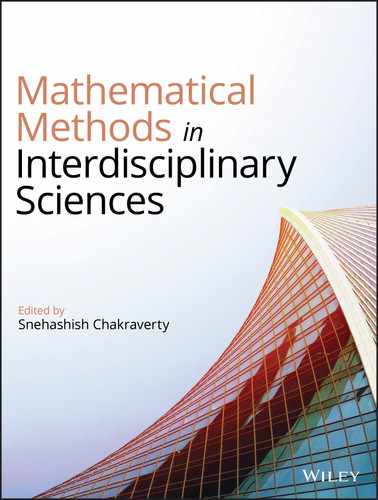Brings mathematics to bear on your real-world, scientific problems Mathematical Methods in Interdisciplinary Sciences provides a practical and usable framework for bringing a mathematical approach to modelling real-life scientific and technological problems. The collection of chapters Dr. Snehashish Chakraverty has provided describe in detail how to bring mathematics, statistics, and computational methods to the fore to solve even the most stubborn problems involving the intersection of multiple fields of study. Graduate students, postgraduate students, researchers, and professors will all benefit significantly from the author's clear approach to applied mathematics. The book covers a wide range of interdisciplinary topics in which mathematics can be brought to bear on challenging problems requiring creative solutions. Subjects include: The book also covers topics as diverse as soft computing and machine intelligence. It concludes with examinations of various fields of application, like infectious diseases, autonomous car and monotone inclusion problems.
Table of Contents
- Cover
- Notes on Contributors
- Preface
- Acknowledgments
- 1 Connectionist Learning Models for Application Problems Involving Differential and Integral Equations
- 2 Deep Learning in Population Genetics: Prediction and Explanation of Selection of a Population
- 3 A Survey of Classification Techniques in Speech Emotion Recognition
- 4 Mathematical Methods in Deep Learning
- 5 Multimodal Data Representation and Processing Based on Algebraic System of Aggregates
- 6 Nonprobabilistic Analysis of Thermal and Chemical Diffusion Problems with Uncertain Bounded Parameters
- 7 Arbitrary Order Differential Equations with Fuzzy Parameters
- 8 Fluid Dynamics Problems in Uncertain Environment
- 9 Fuzzy Rough Set Theory‐Based Feature Selection: A Review
- 9.1 Introduction
- 9.2 Preliminaries
- 9.3 Fuzzy Rough Set‐Based Attribute Reduction
- 9.4 Approaches for Semisupervised and Unsupervised Decision Systems
- 9.5 Decision Systems with Missing Values
- 9.6 Applications in Classification, Rule Extraction, and Other Application Areas
- 9.7 Limitations of Fuzzy Rough Set Theory
- 9.8 Conclusion
- References
- 10 Universal Intervals: Towards a Dependency‐Aware Interval Algebra
- 10.1 Introduction
- 10.2 The Need for Interval Computations
- 10.3 On Some Algebraic and Logical Fundamentals
- 10.4 Classical Intervals and the Dependency Problem
- 10.5 Interval Dependency: A Logical Treatment
- 10.6 Interval Enclosures Under Functional Dependence
- 10.7 Parametric Intervals: How Far They Can Go
- 10.8 Universal Intervals: An Interval Algebra with a Dependency Predicate
- 10.9 The S‐Field Algebra of Universal Intervals
- 10.10 Guaranteed Bounds or Best Approximation or Both?
- Supplementary Materials
- Acknowledgments
- References
- 11 Affine‐Contractor Approach to Handle Nonlinear Dynamical Problems in Uncertain Environment
- 12 Dynamic Behavior of Nanobeam Using Strain Gradient Model
- 13 Structural Static and Vibration Problems
- 13.1 Introduction
- 13.2 One‐parameter Groups
- 13.3 Infinitesimal Transformation
- 13.4 Canonical Coordinates
- 13.5 Algorithm for Lie Symmetry Point
- 13.6 Reduction of the Order of the ODE
- 13.7 Solution of First‐Order ODE with Lie Symmetry
- 13.8 Identification
- 13.9 Vibration of a Microcantilever Beam Subjected to Uniform Electrostatic Field
- 13.10 Contact Form for the Equation
- 13.11 Reducing in the Order of the Nonlinear ODE Representing the Vibration of a Microcantilever Beam Under Electrostatic Field
- 13.12 Nonlinear Pull‐in Voltage
- 13.13 Nonlinear Analysis of Pull‐in Voltage of Twin Microcantilever Beams
- 13.14 Nonlinear Analysis of Pull‐in Voltage of Twin Microcantilever Beams of Different Thicknesses
- References
- 14 Generalized Differential and Integral Quadrature: Theory and Applications
- 15 Brain Activity Reconstruction by Finding a Source Parameter in an Inverse Problem
- 16 Optimal Resource Allocation in Controlling Infectious Diseases
- 17 Artificial Intelligence and Autonomous Car
- 18 Different Techniques to Solve Monotone Inclusion Problems
- Index
- End User License Agreement
